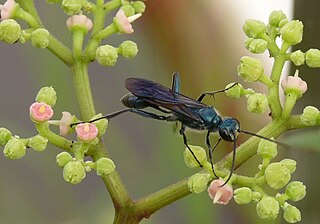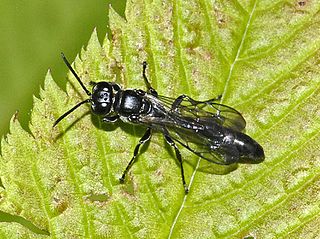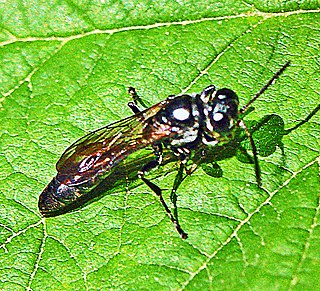
Sceliphron, also known as black mud daubers or black mud-dauber wasps, is a genus of Hymenoptera of the Sphecidae family of wasps. They are solitary mud daubers and build nests made of mud. Nests are frequently constructed in shaded niches, often just inside of windows or vent openings, and it may take a female only a day to construct a cell requiring dozens of trips carrying mud. Females will add new cells one by one to the nest after each cell is provisioned. They provision these nests with spiders, such as crab spiders, orb-weaver spiders and jumping spiders in particular, as food for the developing larvae. Each mud cell contains one egg and is provided with several prey items. Females of some species lay a modest average of 15 eggs over their whole lifespan. Various parasites attack these nests, including several species of cuckoo wasps, primarily by sneaking into the nest while the resident mud dauber is out foraging.

Pison is a cosmopolitan genus of wasps within the family Crabronidae. The genus comprises 145 described species, although many species, especially in South America remain undescribed.

The subfamily Crabroninae(digger wasps) is the most diverse group in the wasp family Crabronidae, containing over 110 genera and 4,800 described species. The subfamily consists of solitary, predatory wasps. The adult females of many groups dig tunnels in the ground for nesting, but others use different techniques, including the construction of tube-like mud nests.

Chalybion is a genus of blue mud dauber wasps in the family Sphecidae. Chalybion species nest in a wide range of natural and artificial cavities such as holes in wood, walls, plant stems, etc., where they typically provision their brood cells with paralyzed spiders. They also reuse old nests of other wasps like Trypoxylon and Sceliphron.

Grace Adelbert Sandhouse (1896–1940) was an American entomologist.
Polistes erythrocephalus is a species of paper wasp in the subfamily Polistinae of family Vespidae found in Central and South America. P. erythrocephalus is a eusocial wasp, meaning that it possesses both reproductive and non-reproductive castes. The cooperation between the two castes to raise young demonstrates the altruistic nature of these wasps. P. erythrocephalus exhibits a four-stage colony cycle, as do many other Polistes wasps. This species generally feeds on larvae, occasionally their own, and is preyed upon by species such as army ants.

Pseudomalus auratus is a species of cuckoo wasps.

Trypoxylon is a genus of wasps in the family Crabronidae. All Trypoxylon species that have been studied so far are active hunters of spiders, which they paralyse with a venomous sting, to provide as food to their developing larvae. Depending on the species, they will either construct their own nest from mud or find cavities that already exist. These cavities can range from keyholes to nail holes to previously abandoned nests, and are generally sealed with mud to create cells for their larvae.

Juan (Jean) Brèthes, also known as Frère Judulien Marie or Juan Brethes was an Argentine scientist, naturalist, entomologist, ornithologist, zoologist and geologist. He was the first entomologist of the National Museum, today known as the Argentine Museum of Natural Sciences. He was a close collaborator of Florentino Ameghino, and translated several of his works into French. Thanks to his intense activity, he systematized a large number of Latin American insect species. He was a precursor in the fight against agricultural pests at a time when insecticides had not been developed to combat them.

Trypoxylon scutatum is a predatory wasp in the family Crabronidae.
Trypoxylon frigidum is a species of square-headed wasp in the family Crabronidae. It is found in North America.
Trypoxylini is a tribe of traditional Sphecidae in the family Crabronidae. There are at least 840 described species in Trypoxylini.

Trypoxylon collinum is a species of square-headed wasp in the family Crabronidae. It is found in North America. It nests inside hollow tubes.
Trypoxylon lactitarse is a species of square-headed wasp in the family Crabronidae. It is found in Central America, North America, and South America. These are fairly common harmless black wasps that build muddy elongate nests on the external walls of houses and low-story apartments. Their characteristic nests resemble pan-flutes in shape, and are provisioned with spiders captured and paralysed by the mother wasp. It lays an egg within each elongate nest cell amongst the invalid spiders, from which a larva will hatch and slowly consume all spiders as food. This species apparently undergoes four larval moults until completing their development as pupae inside a black cocoon.

Trichrysis cyanea is a species of cuckoo wasps, insects in the family Chrysididae.

Chrysis angustula is a species of cuckoo wasps, insects in the family Chrysididae.
Amnon Freidberg was an Israeli entomologist. In his career he described 257 new insect taxa, predominantly flies.
H. Jane Brockmann is an emeritus professor at the University of Florida known for her research on animal behavior, especially in the mating and nesting behavior of horseshoe crabs. In 2008, she was elected a fellow of the American Association for the Advancement of Science.












